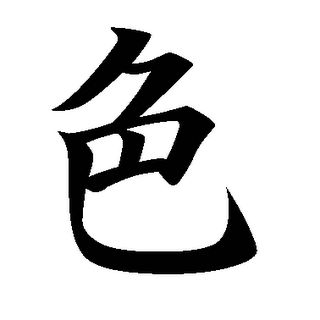Unlike in English, the writing system itself holds meanings, rather than being simply a vessel for those of the language. These meanings are often not reflected in the spoken word at all. Indeed, many native Japanese words have totally different roots from the Chinese characters that have been assigned to them. However, the meanings persist and create a kind of visual poetry hovering like a ghost over the written language. This pictorial and symbolic meaning traces a long and often complex history back to the character system which emerged in the Yellow River region of China between 3,500 and 4,000 years ago.
What I mean by "visual poetry" is difficult to explain without examples. Two of my favourites from my most recent batch of kanji are the characters for green (midori) and colour (iro). First, green:

The character has two elements. If you chopped it down the middle, the bit to the left depicts a thread. The bit to the right depicts liquid (the bottom part looks very much like the symbol for water) and may derive from the depiction of wine falling from a basket used as a crude wine press. This element came to have an association with "oozing" or "exuding" and, more specifically, through its use in another kanji linking it to the element for metal, with the green rust that oozes out of copper. Thus, green threads and, now, green in general. In my mind, I have an image of a thread of green rust trailing down a copper inscription deep in China's interior.
The next one is a bit easier and a bit cruder. Colour or "iro":

The little fin thing at the top is a stylised representation of a person bending. The bit below (the two boxes and the tail) originally depicted a person kneeling but also came to indicate a person bending. Thus, one person bending over another. A reference to sex! Saucy!
The word still has strong sexual connotations. But how did it come to mean colour? According to my textbook: "Many scholars feel that it was used to refer to sexual partner, expecially from a male perspective, and that it then came to mean sexually attractive, leading in tiem to attractive/pretty in a general sense and then by association to colourful." Tenuous but it added colour to a long kanji learning day.
4 comments:
OK I get the poetry stuff but how the heck are you supposed to remember how to write them?
With difficulty, I suppose.
Good job I am not in Taiwan or Hong Kong, where you need in excess of 4000-5000 kanji to read your average newspaper article (the standard traditional chinese dictionary actually includes 50,000 characters but even the non mainland Chinese, who have not modernised, do not usually use all of them). 50,000 though!
I is actually easier to remember these characters the more you get into them. They often have common characteristics. For instance, the thread element on the left of "midori" is repeated in a number of kanji and so you can import it as a block from the memory bank when you encounter a new thread kanji. I have to say, though, that learning how to write and learning how to read these things are two entirely different propositions. I am making some headway on the reading recognition but the writing is hard. Remember the order in which the strokes are made does make it a bit easier, but I think, for many characters, I am going to have to make friends with them by reading them before I am able to write them reliably. (The computer also makes things a bit easier in terms of writing because you can write in one of the two syllabaries and then chose from the choice of kanji that pop up). That was a long and very boring post, sorry.
My mind is trying to relate your writing skill(!) in English being applied to kanji!
Post a Comment